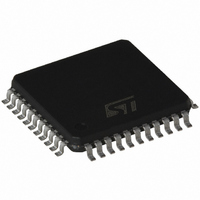TDA7407D STMicroelectronics, TDA7407D Datasheet - Page 29

TDA7407D
Manufacturer Part Number
TDA7407D
Description
IC PROCESSOR ADV SIGNAL 44-LQFP
Manufacturer
STMicroelectronics
Type
Car Signal Processorr
Datasheet
1.TDA7407.pdf
(46 pages)
Specifications of TDA7407D
Applications
Automotive Systems
Mounting Type
Surface Mount
Package / Case
44-LQFP
Lead Free Status / RoHS Status
Lead free / RoHS Compliant
Available stocks
Company
Part Number
Manufacturer
Quantity
Price
Part Number:
TDA7407D
Manufacturer:
N/A
Quantity:
20 000
TDA7407
5.2.7
5.2.8
5.2.9
5.2.10
LEVEL Input and Gain
To suppress undesired high frequency modulation on the highcut and stereoblend function
the LEVEL signal is lowpass filtered firstly.
The filter is a combination of a 1st order RC lowpass at 53kHz (working as anti-aliasing
filter) and a 1st-order switched capacitor lowpass at 2.2kHz. The second stage is a
programmable gain stage to adapt the LEVEL signal internally to different IF device (see
Testmode section 5 LEVELINTERN).
The gain is widely programmable in 16 steps from 0dB to 10dB (step = 0.67dB). These 4
bits are located together with the roll off bits in the "Stereo decoder adjustment" byte to
simplify a possible adaptation during the production of the car radio.
Stereoblend control
The stereoblend control block converts the internal LEVEL voltage (LEVEL INTERN) into an
demodulator compatible analog signal which is used to control the channel separation
between 0dB and the maximum separation. Internally this control range has a fixed upper
limit which is the internal reference voltage REF5V. The lower limit can be programmed
between 29.2% and 58%, of REF5V in 4.167% steps (see
To adjust the external LEVEL voltage to the internal range two values must be defined: the
LEVEL gain LG and VSBL (see
separation is reached (VST) the LEVEL gain LG has to be defined. The following equation
can be used to estimate the gain:
The gain can be programmed through 4 bits in the "Stereo Decoder Adjustment" byte.
The MONO voltage VMO (0dB channel separation) can be choosen selecting VSBLAll
necessary internal reference voltages like REF5V are derived from a bandgap circuit.
Therefore they have a temperature coefficient near zero. This is useful if the fieldstrength
signal is also temperature compensated.
But most IF devices apply a LEVEL voltage with a TC of 3300ppm. The TDA7407 offers this
TC for the reference voltages, too. The TC is selectable with bit D7 of the "stereo decoder
adjustment" byte.
Highcut control
The highcut control setup is similar to the stereoblend control setup: the starting point VHCH
can be set with 2 bits to be 42, 50, 58 or 66% of REF5V whereas the range can be set to be
17, 22, 28 or 33% of VHCH
Functional description of the noiseblanker
In the automotive environment the MPX signal is disturbed by spikes produced by the
ignition, for example; the wiper motor. The aim of the noiseblanker part is to cancel the
audible influence of the spikes.
Therefore the output of the stereo decoder is held at the actual voltage for a time between
22 and 38μs (programmable).
L
(Figure
G
=
Figure
-------------------------------------------------------------------------------------- -
Field strenght voltage [STEREO]
22).
21). To adjust the voltage where the full channel
REF5V
Figure
21).
Multipath detector
29/46













